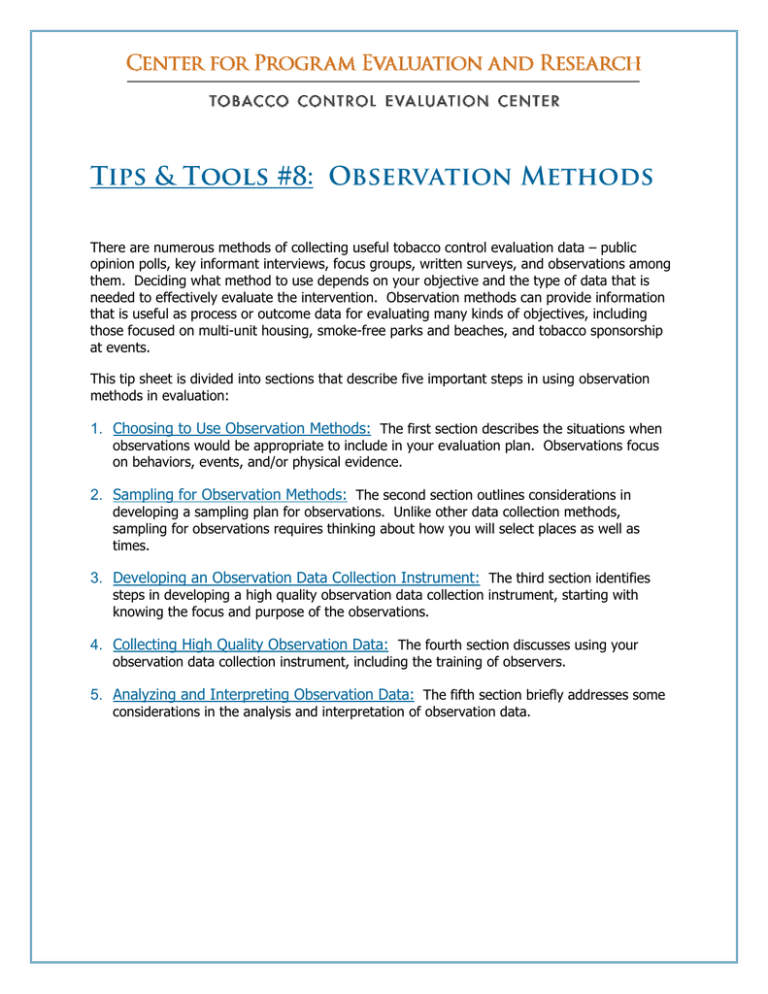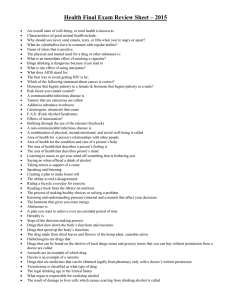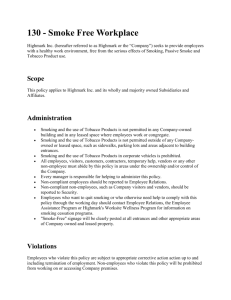Tips & Tools #8: Observation Methods
advertisement

Tips & Tools #8: Observation Methods There are numerous methods of collecting useful tobacco control evaluation data – public opinion polls, key informant interviews, focus groups, written surveys, and observations among them. Deciding what method to use depends on your objective and the type of data that is needed to effectively evaluate the intervention. Observation methods can provide information that is useful as process or outcome data for evaluating many kinds of objectives, including those focused on multi-unit housing, smoke-free parks and beaches, and tobacco sponsorship at events. This tip sheet is divided into sections that describe five important steps in using observation methods in evaluation: 1. Choosing to Use Observation Methods: The first section describes the situations when observations would be appropriate to include in your evaluation plan. Observations focus on behaviors, events, and/or physical evidence. 2. Sampling for Observation Methods: The second section outlines considerations in developing a sampling plan for observations. Unlike other data collection methods, sampling for observations requires thinking about how you will select places as well as times. 3. Developing an Observation Data Collection Instrument: The third section identifies steps in developing a high quality observation data collection instrument, starting with knowing the focus and purpose of the observations. 4. Collecting High Quality Observation Data: The fourth section discusses using your observation data collection instrument, including the training of observers. 5. Analyzing and Interpreting Observation Data: The fifth section briefly addresses some considerations in the analysis and interpretation of observation data. 1. Choosing to use observation methods When would you use observation methods to collect evaluation data? Observations can be used to gather process and/or outcome evaluation data for your tobacco control project. For example, a project may conduct observations for the purpose of documenting a particular tobacco control problem, and then present the data to a local decision-making board to encourage the adoption of a policy that addresses the problem. Observation data can also be valuable in determining the extent to which an objective has been achieved. By gathering observation data before the intervention has begun and again one or more times after the intervention has been carried out, it is possible to document changes in what is being observed. In general, observation is an appropriate data collection choice in the following situations: You are trying to understand or assess an ongoing process, behavior, unfolding situation or event. For example: You want to document any changes in smoking behavior that occur at a rodeo after the airing of an anti-tobacco policy public service announcement. Your project plans to assess the level of compliance with a policy designating common outdoor areas at a multi-unit housing complex as smoke-free by observing smoking behavior near the entrances and playground. There is physical evidence that can be readily observed. For example: Your project’s objective is to decrease the amount of tobacco litter at a county beach. Volunteers are recruited and trained to record their observations of tobacco refuse both before and after policy signs are posted and trash cans provided outside the no-smoking area . You want to assess compliance with a voluntary policy prohibiting the sale of tobacco products in pharmacies. You look for the presence of cigarette or chew tobacco displays behind the check-out counter and record your observations. Other data collection procedures are inadequate for your purpose or seem inappropriate. For example: When city council meeting minutes are not detailed, an observer can record dynamics and concerns during a city council meeting discussion about a tobacco control agenda item. Rather than ask directly as part of a public opinion poll, your project unobtrusively records the gender composition of a sample of county fairgoers. To assess the cultural competence of a cessation class, trainers can observe each others’ cessation classes with low-literacy, low SES farm workers, noting the level and nature of class member participation. Observation Methods 2. Developing a sampling plan for observations While it is possible in some situations to observe a census of cases, it is often not practical to observe every instance at all times. For example, it would be difficult to observe smoking behavior during the entire time of a local fair in all areas of the fairgrounds. In that case, sampling is used to reduce the data collection burden. Samples are selected randomly, purposively, or by convenience. * Sampling for observations differs from sampling for other data collection methods because you have to consider how you are selecting places and times. Sampling locations: Select locations based on the objective. You may be able to use random sampling to increase your ability to generalize from the data, but often purposive sampling is more feasible. Convenience sampling is not recommended. To observe smoking behavior at a fair, a purposive sample might focus on areas around popular exhibits, especially those that draw both children and adults. To observe evidence of tobacco sponsorship at bars, you could purposively select bars that attract young adults, since they are most at risk of taking up smoking. Alternatively, you could purposively sample for diversity in types of bars (college bars, gay bars, western bars) to learn if a sponsorship policy was more successful in one kind of bar than another. (See the Tobacco Sponsored Bar, Fraternity, Adult-only Event Observation form on the Project Smart Money website.) To observe tobacco litter on beaches, it may be possible to randomly select sections of the beach, which would allow you to draw conclusions about the average amount of tobacco litter over the whole beach. Sampling times: Consider variations in the thing being observed by time of day, days of the week, and seasons of the year. * To observe smoking behavior at a fair, you could purposively conduct the observations on the days and the time of day of peak attendance. For example, if you observe on Monday mornings, you are probably less likely to observe smoking behavior than if you observe on Saturday afternoons. (Note, however, that your conclusions would be about the amount of smoking observed at peak times, not the amount of smoking in general at the fair.) It is especially important to consider seasonal effects if you are doing pre-intervention and post-intervention observations. For example, if you observe tobacco litter on a beach in March for the pre-intervention observation, and August for the postintervention observation, you may see an increase in tobacco litter just because the beach is used a lot more in the summer months. Ideally, you will conduct the pre- and post-observations in comparable seasons. See OTIS Evaluation Guide (March 2007), p. 87, for definitions of random, purposive, and convenience samples. Observation Methods Decide how to time the observation. Observations are often timed to specific intervals. For example, if you are observing smoking behavior at entryways on a college campus, you may want to conduct several 30 minute observations (from 10:00 to 10:30 and from 1:00 to 1:30, for example). (Note that you will want to consider variations in traffic in and out of the entryway over the course of the day to determine what time of day to conduct the interval observations.) Observations can also be timed to specific points. For example, if you are observing smoking behavior at a crowded rodeo, there may be so many people smoking at one time that it would be hard to keep up if you had to count them over an interval of more than a couple of minutes. If so, then maybe you want to count all instances at a series of points (for example at 1:00, 1:15, 1:30 & so on, or at randomly selected time points). Some observations can be timed to specific events, such as the observation of an attempted purchase of tobacco in a Youth Tobacco Purchase Survey. Observation Methods 3. Finding or developing an observation data collection instrument Let the project objective determine what to observe. The possibilities for observations are almost limitless – people, behaviors, physical settings, physical evidence, and more. Even within a single event or setting, such as a county fair or a beach, a variety of elements can be observed in order to obtain the process or outcome data needed for your tobacco control evaluation. The elements you decide to observe are determined by the specific objective of the project. For example: If your project is focusing its efforts on adoption of a policy that designates an annual family sporting event as tobacco-free, observation data may be collected as part of the process evaluation to help educate decision-makers about the extent of the problem. If the objective includes the implementation of voluntary policies banning smoking in a local casino, then smoking behavior in the casino can be observed before the intervention as a baseline measure. The baseline data can then be compared to observation data on smoking behavior collected after the intervention in order to measure the outcome of the intervention. Define the focus of the observation. There is likely to be much more going on in the area where the observations take place than what needs to be recorded, so it is important to decide what information to capture for your project’s purpose. For example: If the objective is about increasing compliance with a “no smoking on the beach” policy, it is not necessary to be paying attention to the number of people wearing t-shirts or hats with tobacco-related graphics. On the other hand, with an objective focused on tobacco sponsorship at bar events, observations of such t-shirts and hats might be important. Be specific about what needs to be recorded. In order to end up with observation data that is useful you will want to provide clear instructions about what is to be observed. For example: For smoking behavior, is the observation limited to seeing people actually smoking or should the presence of tobacco litter also be recorded? If you’re observing smoking behavior, does holding a pack of cigarettes count? What if 2 people are sharing 1 cigarette? Develop a systematic method for recording observations. In tobacco control evaluation we are often looking for specific evidence or occurrences, like the presence or absence of posted tobacco policy signage or the number of people smoking in a particular area. In order to make these observations useful for your project, they need to be recorded through one or more of the following means. Observation Methods Recording sheets or checklists are used to record observations in either a YES-NO manner or on a rating scale to indicate the extent or quality of the behavior or thing that is observed. Forms such as these are useful when there are specific and observable items, actions, or attributes to be observed. For example, in tobacco control we are familiar with the use of recording sheets/checklists for noting the placement of tobacco advertising signs on interior and exterior surfaces of tobacco retail outlets. Observation guides are forms that provide space for recording observations. Like checklists, they are particularly useful to ensure uniformity in the type of data collected when several observers are involved, or when you wish to obtain comparable information from several observation sites. The more structured the guide, the easier it will be to tally the results but the less opportunity there will be to record variations or unexpected occurrences. Observation guides may have spaces to describe what is observed in a short narrative in addition to more structured sections for recording certain observations. Observation data collection instruments are available by contacting the TCEC (530-297-4659 or tobaccoeval@ucdavis.edu). Photos and videotapes can be useful in recording observations. The camera makes a record that can be used as a primary data source or to support and illustrate your written notes. Develop an observation protocol. A protocol is a description of what the observer is supposed to do. If your project is doing an observation of entryways, the protocol might give information on where the observer should stand. The protocol can also help the observer with sampling by describing how long to observe (for interval timing) or how to determine the points of observation (for point timing). Often the protocol is incorporated into the data collection instrument, but for more complex observations, a separate protocol may be needed. Pilot-test the observation data collection instrument and protocol. Sometimes problems with a data collection instrument don’t become apparent until after you are using the tool. For example, you may discover that the instructions are unclear, or that the observation guide needs to be more specific. Pilot-testing the observation tool – trying it out in a realistic setting before starting formal data collection – can reveal these problems so that you can fix the instrument before beginning data collection. Pilot -testing is always recommended in order to ensure the best quality data. Consult with your local program evaluator or the Tobacco Control Evaluation Center if you have questions about pilot testing. Observation Methods 4. Collecting high quality observation data Identify your observers. Depending on resources and other considerations, your project may depend on staff, the local program evaluator, coalition members, community members, or other volunteers to conduct the observations. Train your data collectors. If each person gathering evaluation data uses the data collection instrument in a different way, or if one person using the instrument uses it differently each time he/she records observations, the quality of evaluation data will suffer. Even if your project is using a standardized observation form, it is important to provide data collection training in order to be sure that observations are being recorded in a consistent way by each observer and across sites. The level and amount of training will depend on the complexity of the observations and the individual capabilities of the observers. An experienced evaluator should conduct the training, which should include an orientation to the purpose of the evaluation and how the observation data will be used. The training should clarify the definitions of the different elements in the observation form, specify what to look (or listen) for, and describe how to record the observations. If rating scales are used, provide a clear explanation of ratings, using examples to demonstrate the distinctions between the different scores. Use practice observations and comparison of observation results with other observers to reinforce the information in the training and to increase consistency across observers. The goal is to have all the observers look for the same things, use similar meanings for what is seen or heard, and record observations in like manner. The instrument pilot test can become part of the training. This allows for quality control of the instrument and the data collection process at the same time. After the pilot test, observers can discuss with their trainer what difficulties they encountered with the instrument and share their experiences with each other. Flaws in the instrument and possible mistakes made by observers can be discussed and corrected. Observation Methods 5. Analyzing and interpreting observation data Once your project’s observations are recorded, how will you make sense of the data? First, you need to organize and summarize the findings. Typically, quantitative and/or categorical observation data is analyzed using descriptive statistics like simple frequencies and percentages, and sometimes other statistical methods. Qualitative data, on the other hand, is usually analyzed via content analysis which is a method of organizing and summarizing data that is in narrative form. The Content Analysis tip sheet on the TC Evaluation Center’s website may be useful. Just as survey data can be interpreted in different ways, what you see and hear can be interpreted in various ways by different people or even by yourself at different times. Of course, certain kinds of evaluation data leave less room for interpretation than others. For example, interpreting summaries of the number of people smoking cigarettes in outdoor areas of local restaurants is fairly straightforward, while reporting on observations of City Council meetings may require more discussion of the data with others working on the project in order to minimize individual biases in the interpretation and analysis of results. Sometimes the collection of observation data leads to the realization that more information is needed. Does the fact that 3 members of the city council did not comment during a meeting on their position regarding a tobacco control measure being considered mean that those individuals are not interested in seeing the policy adopted? Perhaps in this case it is necessary to speak with these members individually, or review minutes of previous meetings, to assess their support for or against the policy rather than relying solely on what is seen or heard at a particular meeting. From deciding to conduct observations, finding or developing an appropriate data collection tool and training the observers, to collecting and analyzing the data -- being thoughtful and systematic at every step will help establish observation as a credible data collection method for your project, and will enable you and others to benefit from what was learned during the evaluation of your project’s tobacco control efforts. Once your project’s observation data has been collected and analyzed, you will use Tell Your Story: Guidelines for Preparing a High Quality Final Evaluation Report (2007) as a guide for how to report the results of your evaluation. The checklist at the back of Tell Your Story describes what kinds of information to include when describing your data collection procedures and presenting your findings. Acknowledgement: “Collecting Evaluation Data: Direct Observation,” a tip sheet developed by Ellen Taylor-Powell and Sara Steele at the University of Wisconsin-Extension, served as a starting point for this Tips & Tools. The University of Wisconsin tip sheet is available at: http://learningstore.uwex.edu/pdf/G3658-5.PDF. For more Tips & Tools and other resources, go to our website: http://tobaccoeval.ucdavis.edu Observation Methods





